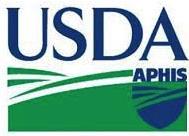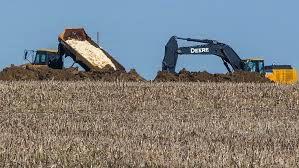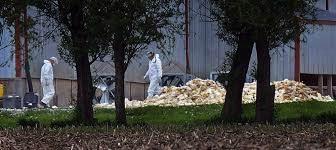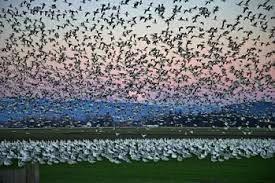 On May 31st, Dr. Amy Delgado, Director of the APHIS Center for Epidemiology and Animal Health, coordinated and presented a webinar on findings arising from the 2022 epornitic of highly pathogenic avian influenza (HPAI) strain H5N1. The study involved a retrospective case-control comparison of egg production farms and turkey grow-out units.
On May 31st, Dr. Amy Delgado, Director of the APHIS Center for Epidemiology and Animal Health, coordinated and presented a webinar on findings arising from the 2022 epornitic of highly pathogenic avian influenza (HPAI) strain H5N1. The study involved a retrospective case-control comparison of egg production farms and turkey grow-out units.
Data was obtained using a questionnaire, apparently expanded from the document used for turkey farms in the 2015 epornitic and was administered by telephone. This is the first and, possibly, the most important deficiency of the approach used to determine risks and protective factors relating to infection. On-site observations and collection of data through direct interview within a short time after outbreaks would have contributed to a more comprehensive understanding of relevant factors. Epidemiology cannot be practiced from an office and by telephone over a long distance. Studies are only as valid as the design of questionnaires and the recording of data. An experienced and proficient observer can frequently determine factors that may be relevant that would not necessarily be captured on a standard one-size-fits-all questionnaire form.
The egg production study involved 18 affected farms and 22 controls. It is generally accepted that to determine the odds ratio relating to a given factor it would have been necessary to have selected at least twice the number of controls as the affected farms. The criterion for inclusion as an egg-production case required 50,000 birds. Given that the greatest financial loss was associated with farms of over one million hens, the study should have concentrated on the ten largest affected farms through May 2022 incorporating detailed, onsite evaluation. Management practices, biosecurity installations and the number and training of personnel differ widely from farms with a 50,000 hen capacity compared to in-line operations with their own packing plants, waste lagoons and feed mixing installations.

The results of the egg production case-control comparisons yielded an odds ratio of 10.3 for a farm being located in an HPAI control area and 5.8 for the presence of wild waterfowl or shore birds in the vicinity of the farm 14-days previous to an outbreak. These findings are not unexpected and are essentially self-evident. Other odds ratio values that emerged from the case-control study were failure to designate personnel for individual barns (6.2); failure to provide protective clothing (4.5); off-site disposal of dead birds (presumably requiring third party or company pickup), 4.1; sharing vehicles and, presumably, feed delivery trailers (3.1). The odds ratio relating to flock size was 2.6, suggesting that introduction of avian influenza and its effect on a complex is essentially an all-or-nothing factor.

Based on the conclusions from the case-controlled study of the selected affected and control farms, there is nothing that could be applied by a practicing poultry health professional to advise clients as to risk factors and their mitigation. There appeared to be an association between access of “wild birds” (not specified) to feed and that cleaning up feed spills was protective.
The study was especially deficient in the area of metrology. It is a frequent, anecdotal observation that high winds occur approximately seven days before an outbreak. This factor was considered only superficially with indications that higher wind speeds may have been involved. This was not correlated with specific parameters including wind direction, velocity and duration and also concurrent humidity and temperature. Given the paucity of metrological data there was no prospect of correlating weather conditions with ventilation systems installed in houses.
The question of mowing was raised with an odds ratio of 2.8 for cutting grass, presumably within the complex, four times per month previous to an outbreak. The question of relevance should have been whether fieldwork was carried out adjacent to the complex within ten days of an outbreak. In addition this factor should have been coupled with wind velocity, duration and direction in relation to houses that first demonstrated infection within a multi-house complex. Given the duration of the epornitic, studies could have been conducted to determine whether virus was disseminated from affected farms with a consideration of distance, wind direction and velocity as conducted in the U.K during the 1972 Essex Newcastle disease epornitic.
 The outstanding question facing those owning or managing large egg-production complexes and their veterinary advisors is how virus shed by wild birds enters farms. Conventional prevention strategies are based on biosecurity that can range from superficial “make believe” procedures based on minimal expenditure and requiring copious quantities of aerosol disinfectant; through “Danish Entry” installations to comprehensive changing and showering of personnel with donning laundered, protective clothing dedicated to the complex. There was no specific detailed evaluation of the structural and operational biosecurity procedures in relation to the risk of infection.
The outstanding question facing those owning or managing large egg-production complexes and their veterinary advisors is how virus shed by wild birds enters farms. Conventional prevention strategies are based on biosecurity that can range from superficial “make believe” procedures based on minimal expenditure and requiring copious quantities of aerosol disinfectant; through “Danish Entry” installations to comprehensive changing and showering of personnel with donning laundered, protective clothing dedicated to the complex. There was no specific detailed evaluation of the structural and operational biosecurity procedures in relation to the risk of infection.
The preliminary report, at least eleven months after it was needed, did not effectively address risk factors nor did it provide indications beyond what is generally known, is taught in veterinary schools and is accepted by the industry, whether applied or not.
It is possible that avian influenza virus enters egg production farms and complexes by a number of routes. Obviously deficiencies in structural and operational biosecurity represent risk factors. Many specific considerations relevant to large operations were not considered due to the deficiencies inherent to the questionnaire used for the retrospective case-control study conducted by APHIS. The second route of entry and gaining credence as an emerging hypothesis, is the possibility that virus shed by carrier birds is deposited on surfaces within close proximity to the farm and then introduced into houses by the aerogenous route. It is noted that a house holding 250,000 hens would be operating with an exhaust fan displacement of 1.2 to 1.5 million cubic feet per minute. This would facilitate virus entrained on dust particles entering houses through inlets. If this is in fact, the case, then extreme biosecurity precautions would be ineffective or at best, only partly effective in the absence of high winds and a substantial virus load associated with waterfowl and shore bird populations shedding the virus in the vicinity of the complex. The complexity of transmission of avian influenza predicates a detailed knowledge of the structure and operation of egg production complexes. This presumes commensurate planning and execution of studies to determine or confirm routes of infection and to develop appropriate preventive measures. The APHIS study was essentially irrelevant and uninformative in this respect.
The question of conceptual biosecurity is an important consideration with regard to national policy on prevention and control of HPAI. Outbreaks of avian influenza are associated with the four major flyways. These follow major rivers with adjoining wetlands. The locations of large in-line egg production complexes were selected with proximity to major road and rail access and proximity to corn elevators and soybean crushing plants. This has placed susceptible populations of hens in egg-production complexes along the migratory routes of waterfowl that, since 2020, have been infected with clade 2.3.4.4b of H5N1 expressing an Eurasian genome.
It is become accepted that H5N1 HPAI is now at best, seasonally and regionally endemic based on the duration and extent of infection in the U.S and also paralleled in the E.U. The infection may be introduced on to farms not only by deficiencies in biosecurity but additionally by the aerogenous route from waterfowl shedding the virus. If this is the case, and not adequately addressed by the superficial and inadequately designed and executed retrospective case-control study, eradication of HPAI is an unattainable aspiration. The current hiatus in incident cases is a function of the movement of migratory waterfowl and is independent of any attempts at responsive control by APHIS at great cost and effort. Facing reality, the most appropriate, protective measure would be effective vaccination to create solidly immune populations of commercial flocks.
Rapid diagnosis followed by stamping out of an exotic disease introduced to a limited area is an appropriate response. Persisting with this strategy in the face of a seasonally and regionally endemic disease that is constantly re-introduced by migratory birds is an exercise in futility. Highly pathogenic avian influenza has and will continue to cost the public sector, the industry and above all, consumers large and recurrent expenditures. Avian influenza should be regarded as “the Newcastle disease of the 2020s.” This infection has not been a restraint to production since the universal adoption of immunization. We have successfully administered a portfolio of vaccines extending from the Komaroff live mesogenic strain through a range of live lentogenic attenuated vaccines by mass administration and in parenteral emulsions to more modern vector vaccines.
We must be realistic with regard to the epidemiology of HPAI and make policy decisions on suppression and control that serve the widest range of stakeholders. Vaccination is only one modality but should not be excluded from consideration in the face of potential and existing trade barriers. It must be remembered that egg consumers paid $15 billion more for eggs in 2022 based on the average rise of $2 per dozen. This expense is above and beyond the cost to the public sector for indemnity, logistics and disposal of depleted flocks and the non-compensated expenses borne by producers and the allied industry.